The surprise split of a partnership to transform rail travel in southern Ontario was the result of a train wreck years in the making, sources say.
Five sources, including current and former Metrolinx employees, told The Trillium that its relationship with Deutsche Bahn, the German state railway company contracted to help massively expand GO train service, deteriorated quickly.
Three years after the GO Expansion project was announced, without explanation, Metrolinx dropped Deutsche Bahn and another key partner, who together were supposed to run the trains for the next 23 years.
Internally, Metrolinx told its employees that Deutsche Bahn failed to deliver on key milestones, and that the project must now be scaled back to keep it within its “current funding envelope.” Sources, however, say Deutsche Bahn pushed for ambitious, European-style changes, while some of the Crown agency’s leadership resisted, insistent that things work differently in Canada. Deutsche Bahn said Metrolinx ended the contract after a “significant realignment” in the project’s scope.
As a result, sources say, what could have been a continent-leading regional transit project will likely be downgraded to a more straightforward service expansion. Even those most disillusioned with Metrolinx say it’s important — even exciting — but a major missed opportunity, with years of work and untold millions of taxpayer dollars spent on a project whose vision remains murky.
“It could have been an eight out of 10 railway on the global standard,” said one former Metrolinx employee. “But now it's going to be five out of 10. It's going to be GO, but better, instead of something new.”
‘This is nuts’
GO Expansion is a dull name for a monumental plan.
Since 1967, GO trains have shuttled workers in the Greater Golden Horseshoe to and from their jobs in downtown Toronto. Outside of rush hour, service is typically limited.
In 2018, however, to contend with a rapidly growing population in the region, Metrolinx prepared a business case for GO trains to run every 15 minutes, all day, both ways, on the core lines that carry the most people in and out of Toronto: Lakeshore East and West, Kitchener, Barrie and Stouffville. The diesel trains would be electrified, and several stations would be expanded.
Essentially, the agency planned to take the first steps to transforming its commuter train service into a European-style express regional rail system.
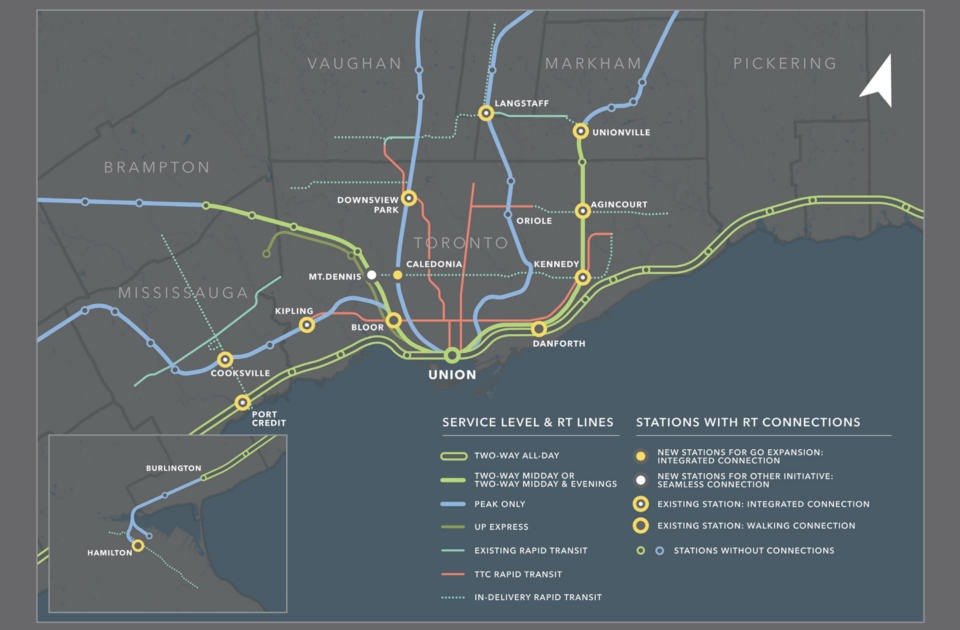
In 2022, the multi-billion-dollar plan became even more ambitious, calling for trains every three to eight minutes at peak hours — and with the backing of Premier Doug Ford's government, fully kicked into motion.
“When we first saw it, we were like, ‘This is nuts,’” one former Metrolinx employee said. They and others were granted anonymity by The Trillium to allow them to speak freely and without fear of reprisal from Metrolinx or their current employers.
Publicly, Metrolinx was also excited. It pitched GO Expansion in 2022 as a project ”unlike anything before in Canada,” comparing it to rail in London, Tokyo, Paris and Sydney.
The ambition was not to last.
Metrolinx leadership, in internal town halls held this year and last, outlined plans to “descope” GO Expansion to cut costs, focusing the project on the two train lines running along the shore of Lake Ontario, delaying many improvements to unspecified future dates.
While the agency’s GO Expansion web page still describes a plan for 15-minute service or better on the main lines, sources mourned the more ambitious version of the project, which they said would have made suburban cores feel fully connected to downtown Toronto, and made rail a top choice for riders looking to travel within the Greater Golden Horseshoe.
“And I think that a lot of people within the agency didn't understand that,” a former Metrolinx employee said. “Or they didn't want it.”
‘I don't think anyone really knows exactly what the vision is’
When GO Expansion kicked off in 2022, Metrolinx handed off building out the track, signalling, and infrastructure for GO Expansion to ONxpress Transportation Partners. The conglomerate was made up of Canadian construction company Aecon, French train manufacturer Alstom, Spanish construction company FCC, and Deutsche Bahn.
The group would essentially handle everything but running the trains. Then, in January 2024, Metrolinx outsourced that, too.
The agency contracted a subset of ONxpress called OOI, or ONxpress Operations Inc., to operate and maintain GO trains for 23 years, starting on Jan. 1, 2025. OOI was made up mostly of Deutsche Bahn with a minority stake held by Aecon.
Despite the stereotype of German efficiency, Deutsche Bahn has a dim reputation in Europe. Recent analyses found that only between 62.7 per cent and 72 per cent of its trains arrive without significant delays.
Still, the German system is far more advanced than Canada’s, where off-peak service is rare and passenger trains have to give way to freight, said Ahmed El-Geneidy, a transportation expert and professor of urban planning at McGill University.
“Their scale is way bigger than us — way, way bigger than us. So they manage a way more complex operating environment than what we have,” El-Geneidy said.
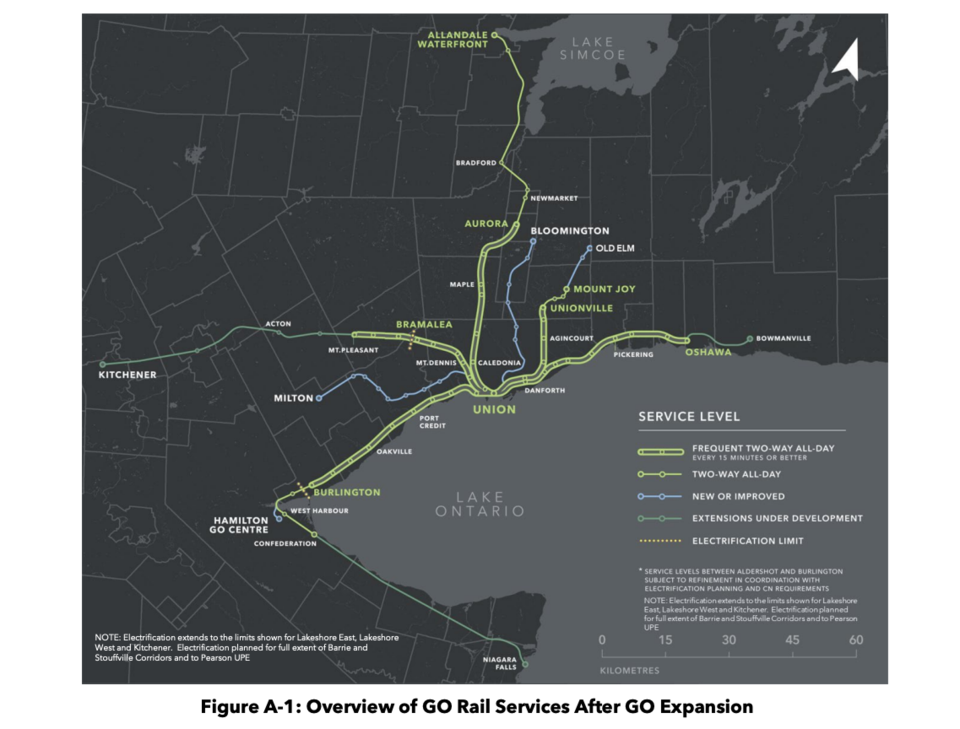
Experts from all over western Europe came to Toronto to work for ONxpress on GO Expansion.
“There was a huge pool of talent here in Ontario for the first time — people who were experienced in working on world-class railways,” a former Metrolinx source said. “The cream of the crop.”
But the Jan. 1 takeover date came and went. It was pushed back, Metrolinx said internally, because Deutsche Bahn wasn’t ready to take over.
Then, on May 15, Metrolinx cancelled its contract with OOI altogether. The agency said Alstom would “maintain its role supporting the operations and maintenance of GO Transit and UP Express, to continue delivering the best-in-class service that Ontarians have come to expect.”
Behind the scenes, all five sources who spoke with The Trillium described an acrimonious relationship between Deutsche Bahn and Metrolinx, with varying degrees of shared blame. One 40-year veteran of North American rail systems who worked for ONxpress said the Germans had an “autocratic” management style and didn’t want to collaborate. Three younger transit experts who yearn for high-frequency intercity rail said Metrolinx stonewalled the very partners it hired to get it done.
Metrolinx’s interim CEO said Deutsche Bahn “weren't close to being ready” to take over on January 1.
“It was a grand vision,” Michael Lindsay, Metrolinx's interim CEO, said in a June 4 town hall about the 2022 plans. “But what clearly was true, not a year later, was that that consortium, and their ability to work with one another to produce that vision, it wasn't happening.”
But five sources said the partnership was hampered by fundamental differences of opinion on the form and function of passenger rail between Deutsche Bahn and Metrolinx, and a lack of vision and leadership on the project from the Crown agency.
They also said proposals from Deutsche Bahn were received negatively, and that the project’s scope is still unclear because Metrolinx frequently changed its mind on major decisions.
“What type of trains are we going to operate? What is Union Station going to look like? What actual service do you want to provide?” an ONxpress source said.
In town halls, Metrolinx leadership described defining the scope of the project as a major challenge that they hoped to figure out soon.
“We’re getting close to being able to articulate … what the plan is going to look like and when service-level enhancements arrive,” Lindsay said on June 4.
In the meantime, questions remain about “what to build, and when to build, and how that ties to a plan of operations,” including the cost and feasibility of the service, coordination with freight rail companies that use the same tracks, and how Union Station will handle the increased service, he said.
“I don't think anyone really knows exactly what the vision is,” one senior Metrolinx employee said, “because it has changed so much.”
‘They weren't really interested in changing the way they ran trains’
To deliver GO Expansion the way Deutsche Bahn proposed would require a massive mindset shift. But many of GO Transit’s most experienced hands are proud of the commuter system they’ve built, sources said.
“There are a lot of people at GO that think running frequent trains in both directions is a kind of a dilution of their mandate, or an unnecessary frill, or a waste of money,” one ONxpress source said.
Even getting buy-in to improve service outside of rush hour was a “huge hurdle,” a former Metrolinx employee said. “Trying to break that mould is really difficult.”
Sources said Metrolinx regularly pushed back against or added new requirements for Deutsche Bahn’s GO Expansion proposals.
“They kept shifting the goalposts of what was considered acceptable,” a former Metrolinx employee said. “So for ONxpress to get anything into service, it was basically impossible.”
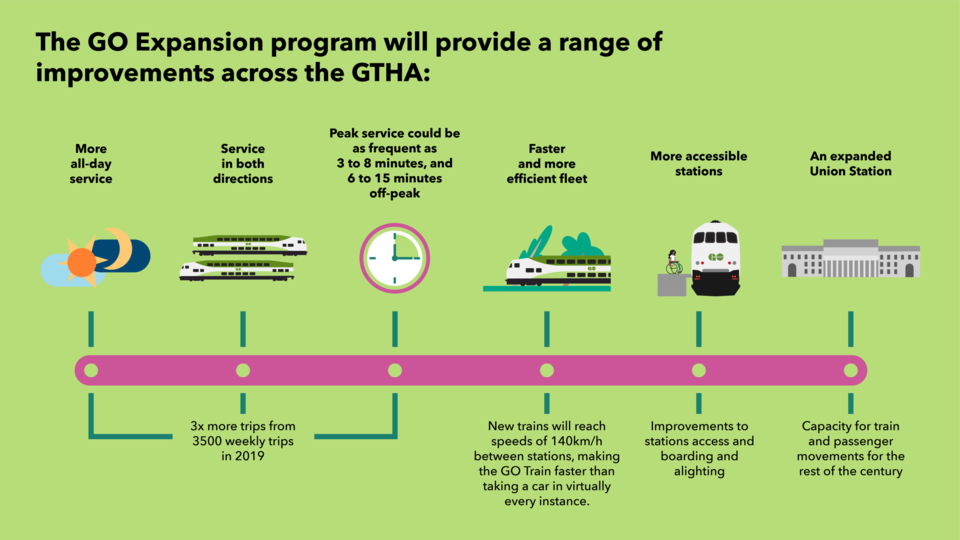
This seemed to confuse Deutsche Bahn’s leadership, who thought they had been hired to take a leadership role, according to three sources.
For example, Deutsche Bahn wanted to revamp how crews were scheduled through automation, four sources said. Some crews spend long stretches of time deadheading or otherwise not carrying passengers — some of which is unavoidable, but it could be improved, several sources said.
One nine-hour shift description viewed by The Trillium called for under two hours of time spent working on a train carrying riders.
Metrolinx was not receptive to Deutsche Bahn’s proposed German scheduling software and discouraged its use in various ways, four sources said.
Four sources said this was due to a disagreement in strategy. The rail veteran who worked for ONxpress, however, said Deutsche Bahn wanted software that hosted data in Germany, which wouldn't be allowed under Canada’s cybersecurity laws.
Even this strong critic of Deutsche Bahn said Metrolinx frequently gave the Germans new requirements focused on improving the agency’s “current methodology” instead of transforming it.
“So they weren't really interested in changing the way they ran trains,” they said.
Decisions about GO Expansion regularly fell to senior management, which led to frustration among employees who saw key proposals deferred across multiple desks until they ended up at the top or disappeared altogether, three sources said.
“Anybody low down in the organization can say no, but it takes the CEO or senior management level to say yes,” a senior Metrolinx employee said.
“So you'd have endless committees, and nobody actually empowered to make a final decision,” an ONxpress source said.
Toward the end of its contract with Deutsche Bahn, two sources said Metrolinx would hire for the same roles posted by ONxpress due to a “deep distrust” of its partner, as one former Metrolinx employee put it.
ONxpress employees spent the majority of their time — several people estimated around 70 per cent — responding to comments from Metrolinx or the government, and the minority building a railway, Metrolinx and ONxpress sources said.
During an internal town hall in May, an employee asked why GO Expansion workers “have spun our wheels for years now, continuously fielding changes” to infrastructure plans, “which has driven a significant and concerning lack of progress.”
“I feel the frustration here. This has also been a huge challenge for us,” Metrolinx vice-president Jake Schabas said.
To decide on infrastructure, the organization has to be “bought in” to the operations plan, he said.
“And the challenge was what we started with three years ago, ultimately, was not something the organization had confidence in,” he said.
“We had a lot of challenges, whether it was the number of trains that were proposed to go over level crossings, to a lack of understanding on the signalling system and a lack of understanding of how Union Station was going to accommodate all these things,” he said.
The bureaucracy may have led to a “clash of cultures” between Metrolinx and Deutsche Bahn, transportation professor El-Geneidy said.
“Usually, in the Canadian context, most of these (operational) decisions are centralized in the head office,” he said.
A senior Metrolinx employee, however, said the agency’s bureaucracy is the cost of a uniquely large North American transit organization with a sterling safety record and good on-time numbers.
“That commitment to operations and safety takes people and time and money,” they said.
A senior Metrolinx employee stressed that those working day-to-day on GO Expansion are largely on the same page.
“But people are far too stuck, especially at a senior level, because they are quote-unquote, ‘railroaders,’ who have been doing this for a long time, and who can't imagine another way of doing things,” they said.
The issues with GO Expansion came from management, that source and others said.
“This wasn't some organic, like, ‘Oh, everybody's realizing that this isn't working,'” they said. “No, it was a very top-down change.”
‘Minimum viable product’
Internal “configuration state” plans from as recently as February 2024 described eventual two-way all-day electrified service on the Lakeshore East and West, Barrie, Stouffville and Kitchener lines.
But at some point, sources said, Metrolinx had “a major rethink” about how the project should be delivered.
In a series of monthly town halls this year and last viewed by The Trillium, the agency said it was taking direct control over the project and would now focus on delivering a “minimum viable product.”
In a January 2025 town hall, Metrolinx executive vice-president Laura Kutisker-Jacobson referred to a “reset” in which the agency “(took) ownership” of several responsibilities that were once under ONxpress.
“They had an opportunity to contribute, but really, Metrolinx is now in the steering seat when it comes to these kind of high-level strategies,” Kutisker-Jacobson said in a town hall last month. “And so we've called this the leaning in. We've called this, Metrolinx becoming the strategic network operator.”
Originally, GO Expansion was supposed to build out capital projects (such as new tracks, signalling and electrification work) on the Lakeshore East and West, Barrie, Kitchener and Stouffville lines, as well as Union Station, said Lucia England, Metrolinx’s vice-president of development and controls, in an October 2024 staff briefing.
Metrolinx has since “pivoted” to focus on Lakeshore East and Lakeshore West, which “generate the most economic benefit,” she said.
The Barrie, Kitchener and Stouffville lines will be addressed in the next "phase" of the minimum viable product, she said.
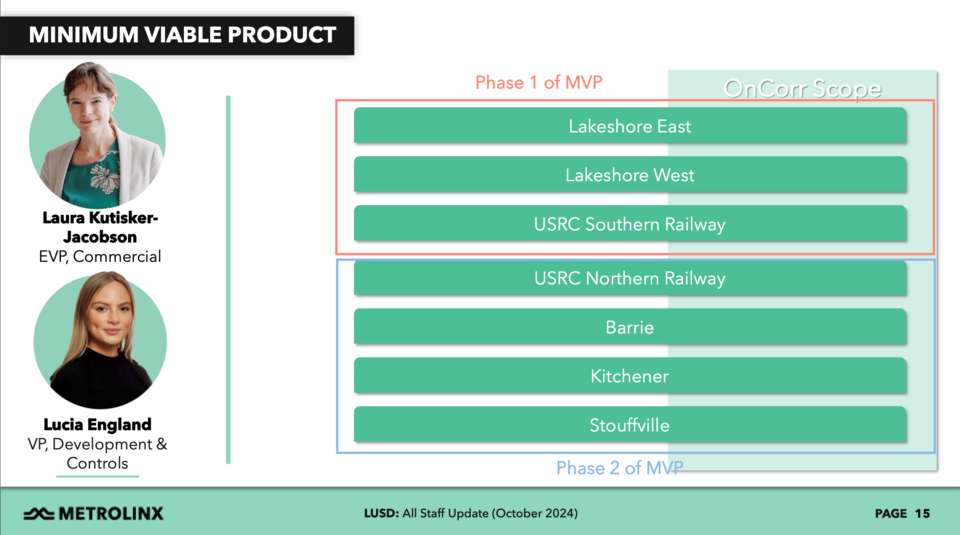
England presented the minimum viable product as "what can be done now versus what can be done in the future," but others made it clear that budget was a major concern.
“There is no point in building infrastructure we may or may not need for 30 years’ time,” Metrolinx deputy chief capital officer Richard Walker said in a November 2024 town hall.
The agency had been trying to “lock down scope for the better part of this year,” he said. “And we’re having to pivot again to make sure that what we’re delivering is value for money.”
The goal is to deliver “the maximum amount of benefit to our travelling public” within the agency’s “current funding envelope,” he said.
"In effect, we are seeing an affordability challenge, as you are probably all aware,” he said.
The number of trains per hour has been cut from 12 to eight, resulting in infrastructure changes, Molly Evans, Metrolinx’s vice-president of track specialized delivery, said in the November town hall.
Metrolinx leaders noted several other “de-scopes” in the town halls, including reductions in speed, cuts to the number and complexity of tracks, and abandoned platform upgrades.
Abandoning speed increases was a gut punch to one senior Metrolinx employee, who said travel time is the top reason people choose to drive, walk, bike or take transit.
“One of the biggest things that is going to really drive that modal share over to the rail network is travel time,” he said.
A high-level schedule presented to staff in April estimates that electrification will be complete in September 2035 for the Lakeshore West line, December 2036 for Lakeshore East, and January 2038 for the Union Station rail corridor.
But a December 2024 town hall only described electrification on the UP Express and Lakeshore lines. Under the minimum viable product, the agency plans to electrify from Burlington to Oshawa GO stations, with a gap at Union Station, Metrolinx consultant Shaun Kearney said in the town hall.
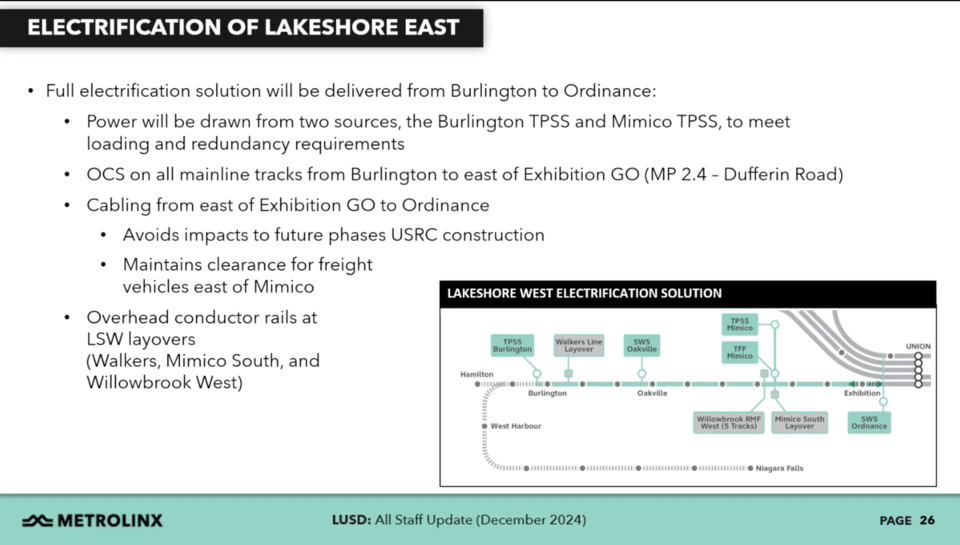
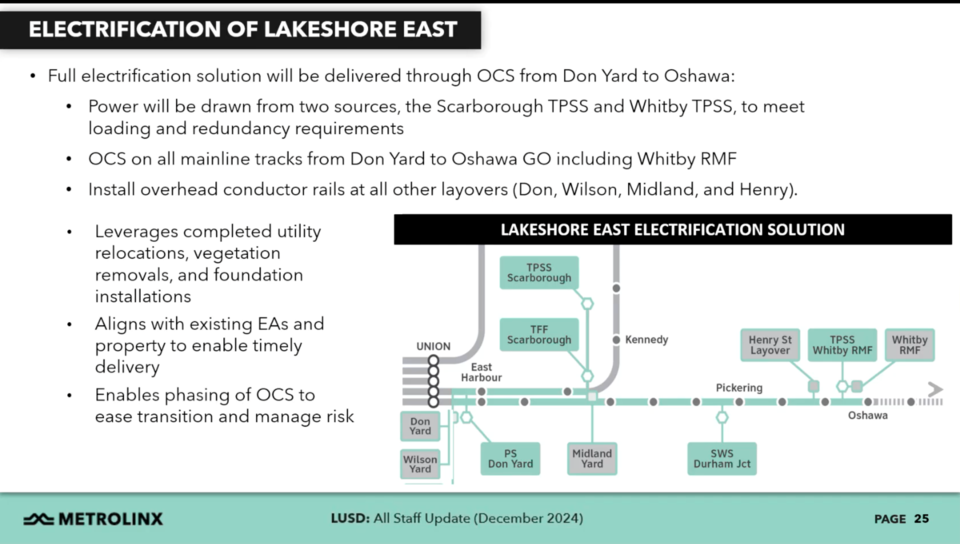
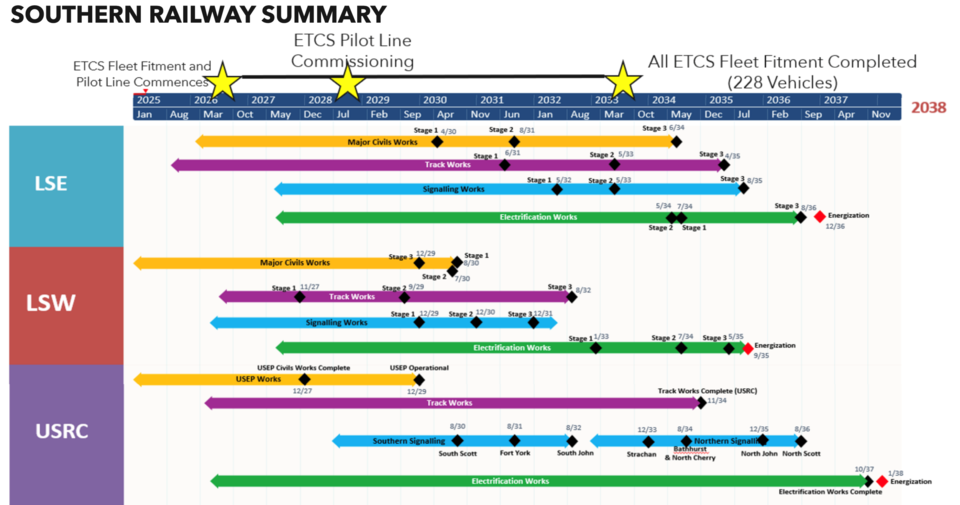
After several town halls, the project remains hazy to five sources.
“The thing that I personally find most frustrating, given that I use this system every day, and I want it to be as good as it can be, is that we're several years into this, and it seems like the plan is less clear now than it was a couple years ago,” a senior Metrolinx employee said.
‘They should learn whom they are dealing with before they sign contracts’
GO Expansion is still happening, providing those who have worked on the project some measure of relief — though Metrolinx won’t say publicly exactly what that means.
In a statement, Deutsche Bahn said the end of the contract was “related to a significant realignment of Metrolinx's strategy, in particular with regard to the modernization and expansion of transport systems and the operation of regional transport in Toronto.”
“We expressly regret this development, but respect the decision,” a spokesperson said.
Deutsche Bahn and Metrolinx declined to answer a list of detailed questions.
OOI and Metrolinx “worked closely toward” the Jan. 1 takeover date, but now “the parties are working on an amicable settlement to end the partnership,” Andrea Ernesaks, a spokesperson for the agency, said in a statement.
Ernesaks didn’t say whether Deutsche Bahn, which was involved in other areas of ONxpress, will continue to do any work for Metrolinx — or whether the scope of GO Expansion has been reduced as a result of Deutsche Bahn’s exit.
Metrolinx did not answer questions about how much had been spent on the partnership, or how much the “amicable settlement” could be.
Two-way all-day GO service on the core network lines is still the plan, and “service increases, signalling, electrification and other works” under GO Expansion are proceeding, she said.
December marked the end of GO Expansion’s “development phase,” and early construction works have begun, Ernesaks said.
Asked at the June 4 town hall when 15-minute all-day service for all lines will happen, Lindsay, the agency’s interim CEO, said he wanted to be transparent “soon,” but only once the agency is “highly confident” about how it gets there.
While Deutsche Bahn wanted to create a regional train system that felt like an “express subway,” several sources said 15-minute, two-way, all-day service is still a worthy goal.
Ontario Liberal MPP Andrea Hazell has requested the auditor general look into Metrolinx’s decision to cancel the contract with OOI.
The contract’s “abrupt cancellation threatens to delay the project by several years, risk hundreds of jobs, disrupt GO Transit and UP Express operations, and undermine public trust in Ontario’s transit planning,” Hazell wrote in her letter to the auditor general.
The auditor general’s office has said the 2025 audits are set, but that she would consider the issue “when selecting future audit topics.”
Meanwhile, Metrolinx is in a weak negotiating position with Alstom, the company it has announced will resume operations of GO Transit, El-Geneidy said.
“Alstom can ask (for) whatever they want,” he said. “So don't expect Alstom to be merciful to Toronto commuters.”
Metrolinx should have laid out its expectations clearly with Deutsche Bahn from the beginning, El-Geneidy said.
“They should learn whom they are dealing with before they sign contracts,” he said.
Lindsay, in the recent town hall, said there are “exciting” conversations taking place about Metrolinx’s role in running the GO network, versus that of third parties. The Alstom extension will be an interim step while those discussions take place, he said.
One senior Metrolinx employee said he was unsure whether the agency would be able to deliver 15-minute service beyond the Lakeshore East and West lines, given the current funding available. The rail veteran who worked for ONxpress said he also had doubts about Metrolinx’s ability to deliver high-frequency rail.
Another senior Metrolinx employee, however, said the work already accomplished and the agency’s public commitments make them optimistic that it will be able to at least get to 15-minute service intervals and electrification.
“That seems to be the only coherent plan at the moment,” they said.
“Honestly,” they said, “that is the part that is keeping me from going full doomer about the project.”
This story was updated after it was initially published to correct a transcription error in a quote from Richard Walker.



